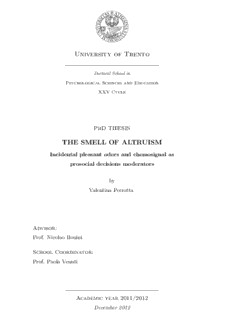
PDF (The smell of altruism: Incidental pleasant odors and chemosignal as prosocial decisions ... PDF
Preview PDF (The smell of altruism: Incidental pleasant odors and chemosignal as prosocial decisions ...
University of Trento Doctoral School in Psychological Sciences and Education XXV Cycle PhD THESIS THE SMELL OF ALTRUISM Incidental pleasant odors and chemosignal as prosocial decisions moderators by Valentina Perrotta Advisor: Prof. Nicolao Bonini School Coordinator: Prof. Paola Venuti Academic year 2011/2012 December 2012 To my mother "Odors have a power of persuasion stronger than that of words, appear- ances, emotions, or will. The persuasive power of an odor cannot be fended off, it enters into us like breath into our lungs, it fills us up, imbues us totally. There is no remedy for it." P. Süskind List of Papers I. Bonini, N., Graffeo, M., Hadjichristidis, C., & Perrotta, V. (Submit- ted). The effects of incidental scents in the evaluation of environmental goods: The role of congruity. Journal of Economic Psychology. II. Perrotta, V., Graffeo, M., & Bonini, N. (Submitted). Lexical and dona- tion decisions under olfactory and visual stimuli Journal of Cognitive Psychology. III. Perrotta, V., Graffeo, M., Bonini, N., & Gottfried, J. A. (In prepa- ration). Low concentrated ambient delivered 4,16-androstadien-3-one makes people more generous in Dictator and Trust games. IV. Perrotta, V., Graffeo, M., Bonini, N., & Gottfried, J. A. (Submitted). The smell of altruism: 4,16-androstadien-3-one makes women happier 2 List of Papers and more generous. Emotion. Abstract The study of the interactions between olfaction and the decision making processes has mainly focused on the investigation of what is considered the most useful odor to disperse in the air to drive the consumers’ choices to prefer a product rather than another one. Despite the fact that some studies showed the existence of associations between odors and prosocial behavior, much less data are available on the links between olfaction and donation in favor of public goods. Thus, the main purpose of the series of experiments described in this thesis is precisely that to shed some light on the investiga- tion of the nature of pleasant odor-decision and on the chemosignal-decision associations. In order to achieve this, the presence of an odor and the congruence between odor and decision task has been manipulated, and the decision to donate has been tested in different domains. Therefore, in the first series of experiments, we manipulated the presence ofanambientpleasantodor, expectingthatthecongruentstimulisharingthe 2 Abstract more stable association odor-concept, would have resulted in an overall in- crease in the WTC (willingness to contribute) and WTP (willingness to pay) in the decision to donate in favor of a public good. The results confirmed the existence of an association between the olfactory stimulus congruence and the amount donated in favor of a public good. Interestingly, this ef- fect is confirmed in both hypothetical and real decision settings. Moreover, the stimulus modality was manipulated presenting congruent olfactory or vi- sual stimuli. Our findings confirmed the preferential link between olfaction and cognitive processes and showed higher donations in the olfactory setting (compared to the visual one). The existence of associations between odors and words are examined to know if the odors could semantically drive cognitive processes different from decision making. The results confirmed the existence of an association be- tween the olfactory stimulus pleasantness and the performance in a lexical decision task (LDT). Thus, this effect is mediated by the presence of a pleas- antodorandnotbythesemanticcongruencebetweenodorandthepresented words. Moreover, the visual modality tend to worsen the LDT performance even if the visual stimulus was semantically congruent with the word pre- sented. Finally, even though the semantic link appears to be crucial for cogni- tive processes such as decision, it seems not so important for memory and linguistic processes involved in the LDT. The second series of studies involved the presence of chemosignal, expect- ing that the congruity between stimulus and decision (the chemosignal used is AND, known as the best candidate to be considered a human chemosignal) would have resulted in an overall increase in amount of money donate to un- known persons during Dictator and Trust Game. The results confirmed the
Description: